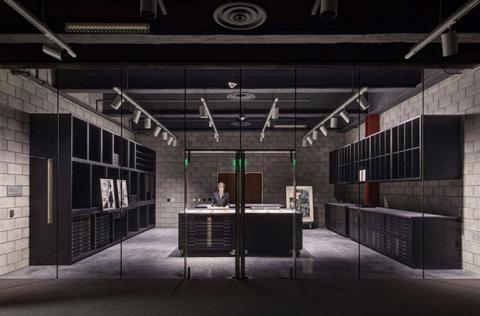
Ask anyone who works at a museum what they love about their job, and chances are they won’t respond “my workspace.” Generally located in the bowels of the building, museum workspaces are notoriously unpleasant: often windowless and, depending on the age of the building, maybe not originally intended as workspaces. Among the several museums at which I’ve worked or interned, my desk has been located in: a busy hallway, a closet for marketing materials, and a repurposed storage room that opened only onto the exhibition space.
I’ve heard similar tales from museum colleagues; more than one has described workspaces located in collections storage areas, which are kept at cooler temperatures and higher humidity levels than are comfortable for human beings. It doesn’t have to be this way! While museums might not be able to provide Silicon Valley-style amenities like lounge rooms upholstered entirely in velour or adult-size slides, good space planning can yield staff workspaces that are pleasant and comfortable to work in without sacrificing collections or visitor areas. Why are museum workspaces so bad? While studies have shown that well-designed workspaces can increase worker productivity and boost team cooperation, museums don’t tend to focus on staff workspaces when allocating resources.
As non-profit institutions dedicated to the preservation and exhibition of collections, museums are far more likely to invest what money they have for capital improvements in the spaces that visitors use and collection objects occupy; as Jamē Anderson, AIA, puts it, “collections will always take priority over people.” Jamē should know; she started her career as an architect, left the field for several years to design exhibitions for the Smithsonian Institution and the National Gallery of Art, and then returned to SmithGroupJJR to focus on the planning and design of museums. In addition to museums’ bias toward collections, major donors want to put their name on a space that the public will see, such as the Sant Ocean Hall at the National Museum of Natural History or the Oprah Winfrey Theater at the National Museum of African American History and Culture.
It can be difficult for museums to raise funds for projects that will be invisible to the public, like mechanical system upgrades or the renovation of staff workspaces. Jamē notes that museum workspaces are further complicated by the fact that many museums occupy historic buildings, with new workspaces carved out in creative ways to accommodate a growing staff within the building’s existing footprint. Jamē laughed when I told her about my desk in a hallway: “That happens more than you know. Corridors become storage units and then offices over time.
On a positive note, things are changing in museums – the work the staff is doing becoming more and more a part of public programming.” Special considerations for museum workspaces While museums can learn a lot from corporate workspaces, they have several key needs that corporate environments do not. As an interior designer at SmithGroupJJR, Jun Kim, NCIDQ, LEED AP, has designed workspaces for both museum and corporate clients. He says the fact that museums are “mission-driven workspaces” whose purpose is to care for and exhibit sensitive collections adds a layer of complexity to the workplace. Museums require a greater variety of workspaces than the average corporate office. For example, most museums need “clean” spaces for the storage and handling of collection objects. These spaces are specially climatized to preserve the objects, and no potential contaminants, like food, are allowed inside. Some museum staff, like curators, registrars, and conservators, use the clean spaces frequently, but these spaces should not be considered any staff member’s primary workspace due to the environmental conditions (although that does happen, as we saw in the opening paragraph of this post) and because many of the characteristics that make for a good workspace, like natural light, are antithetical to the preservation needs of the collection.
Break rooms should be provided near the clean spaces so staff can drink a cup of coffee, look out a window, or even just warm up between stints in the collections spaces. “It’s something that we keep in mind as designers, that there will be people working in the clean spaces as well,” Jun says. Larger museums may house laboratory and workshop spaces. Conservation labs, where staff spend a lot of time peering closely at collection objects, should be outfitted with ergonomic furniture to prevent injury as well as fume hoods to remove chemicals from the air. Some museums are putting conservation on display as a kind of living exhibition; such is the case for the glass-enclosed Lunder Conservation Center at the National Portrait Gallery and Smithsonian American Art Museum. Larger museums might have workshops for framing or exhibit fabrication; these are “dirty” spaces that must be well separated from the “clean” collections and conservation areas.
Of course, museums also have staff with desk jobs, such as administrative personnel, and even staff who spend a lot of time in clean spaces will need a primary workstation outside of the collections-focused areas of the museum. These primary workspaces might look much like a corporate office, with workstations, conference rooms, and break rooms, but with the addition of specialized spaces, such as classrooms for education staff to conduct school programs or a graphics room to contain exhibit designers’ large-format printers.
The Museum of the Bible, on which Jun is currently working, will have a special library and study space for academics visiting the museum through its Scholars Initiative. Although museums are alike in that they are collections-focused institutions, they also differ widely from one another; an art museum will not have the same needs as a natural history museum or a historic house. Large and small museums also have different needs.
Careful architectural programming is necessary to tease out the exact requirements for an individual museum’s workspaces. But what can we do about it? The second part of this post, The Museum as Workspace, Part II, will explore what makes a good workspace, and how museums can incorporate these characteristics into their staff spaces.
